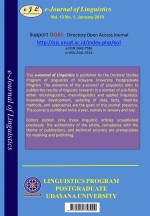Passive Voice Transformation
Abstract
It is well known that the differences between the languages and the different levels of relationship between them and the use of the English passive voice in Albanian language are complex achievements of hypotheses given by language thinkers, because the language first of all is a process and processes change from time to time as a result of new language achievements and transformations and as a result of changes in people's worldview. The English and Albanian passive voice do not have a single grammatical structure and that this should be related to numerous legalities that follow the languages in their internal and external development. The studies carried out in terms of linguistic features, even of the passive voice according to the comparative method, have opened new paths to see similarities and differences even in the passive voice structure. This study is intended to give our modest contribution to notice the similarities and differences in the use of the passive voice as well as its structure in both languages. This contrastive analysis tries to facilitate the acquisition of English as a foreign language for students, pupils, to make the translation from English into Albanian and vice versa easier, to provide linguistic information to language researchers. The comparison is supported by the following English novels and their translated versions in Albanian such as: “Oliver Twist” by Charles Dickens and translated by Skënder Luarasi and “Silas Marner” by George Eliot and translated by Ramazan Hysa, where similar as well as different features have been found.
Downloads
References
Blaganje, D. & Konte, I. (1979). “Modern English Grammar” Drzavna Zalozba Slovenije, Ljubljana.
Huddleston, R. & Pullum, G. (2002). “The Cambridge Grammar of the English Language”, Cambridge University Press, Cambridge.
Quirk, R. & Greenbaum, S. (2003). “A Comprehensive Grammar of the English Language”, Pearson Education, Harlow.
Shibatani, M. (1988). “Passive and Voice”, Amsterdam ∕ Philadelphia.

This work is licensed under a Creative Commons Attribution 4.0 International License.

This work is licensed under a Creative Commons Attribution 4.0 International License











